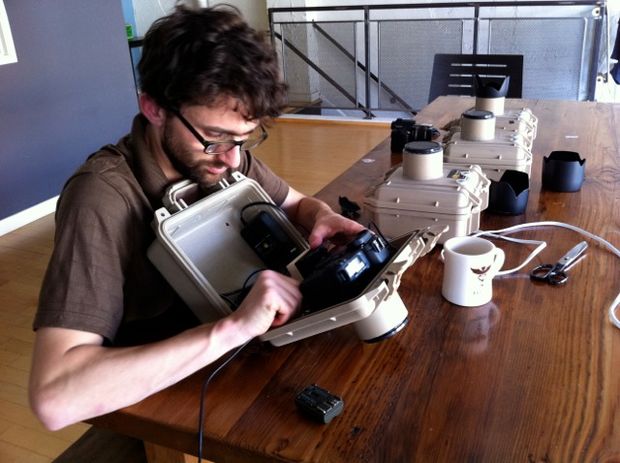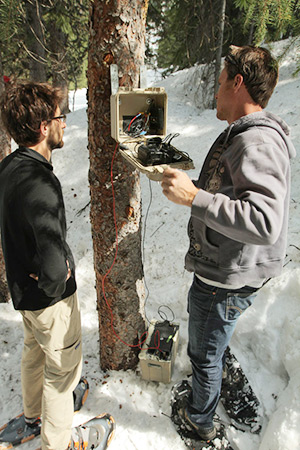Timelapses aren't just for moving clouds and the northern lights (but they sure are pretty) but in fact their use for studying earth sciences is becoming a key part in learning more about our landscape and using the images to educate and inform the masses. I interviewed Forrest Pound of San Francisco based Kontent Films, who was tasked with building custom timelapse rigs to document parts of the Colorado River. He has shared this DIY project step by step, so read on to learn more.
Timelapses have really come a long way in the last few years, especially since the advent of motion-control devices to create fluid movement while capturing multiple stills. One result of this boom in timelapse work is the scientific information discovered through studying geographic phenomena, and how it changes over time. If you haven't seen the movie Chasing Ice, stop what you're doing and watch the trailer. If you have seen it, you probably are aware of the power these kinds of images can have when in the right creative hands.
I've dabbled in timelapses myself, and even considered producing a few projects to document the change of a landscape over time, but I'm not the techie type that could build a system like that with just a few trips to Radio Shack. However, while perusing the website Instructables.com, I found an very interesting and relevant DIY project for making long term timelapse camera boxes. I reached out to the creator of the instructable, Forrest Pound, who is a documentary and activist filmmaker.
Forrest: When the idea for a long term time-lapse came to me, I took it upon myself to figure out how to build the rigs. During the early stages of the project, I was hiking in Point Reyes, north of the city and thinking about how forests act as a water reservoir during dry times- they soak up the water when it rains and trickle it out over the dry months. (the environmental buzz word for this is ecosystem services) I got to thinking how cool it'd be to witness the way the forest floor changed during the course of the season. But because we were working on Watershed, I started to imagine how we could illustrate the complex ecological systems in the Colorado River basin.
Fstoppers: Had you built or worked with long-term TL systems before?
Forrest: Before building the rigs for Watershed, I'd never worked, nor even really thought about Long Term Time-Lapse. I was no stranger to DIY camera rigs though. For example, I motorized a Cinevate slider with servos from Radio Shack to do time-lapse dolly moves. Before he got uber famous for Timescapes, I assisted time-lapse guru Tom Lowe for 2 weeks while shooting a doc about Singularity University on the NASA Ames campus. He showed us everything we needed to make a DIY time-lapse dolly just like the one he used back then.
Fstoppers: What camera bodies and lenses did you go with and why?
Forrest: We bought a used Canon 20D for the body and a lousy 18-55 kit lens. Not the best gear certainly, but we were really worried about camera damage or theft- and the ultimate goal was video, so the megapixels didn't matter too much. If I was going to do it again, I'd love to use an older Nikon prime lens instead. We felt we needed the zoom lens for the flexibility to frame the shot on the fly. But, I think we went as wide as possible for each shot anyway, so that added functionality wasn't really needed. Plus, we had to tape off the zoom in the exact position so it didn't change as we closed the case.
Fstoppers: You referenced the Extreme Ice Survey’s project on your instructables page, and that they had some malfunctioning components. Were there any components in your rig that you suspected might be the weak link? A follow up question – Did you have any systems that failed or didn’t perform as expected? What happened?Forrest: I purchased all the components online and when the voltage converters came, John Behrens, our electrical genius of a DP expressed concern about the reliability of the cheap Chinese made boxes. 2 days before we left, we had to get more reliable ones overnighted to us from Utah. It ended up being totally worth it, but that's why, in the Instructable, I recommend going with the Astronomizer devices. They're purpose built and seem rock solid. In the end, none of our systems failed- all performed exceptionally. It was a huge relief to see the first frames from the cameras as we picked them up.
Fstoppers: Doing this project required you to leave expensive camera systems out in the open, sometimes in remote areas. Were the cameras safe?
Forrest: There was quite a bit of nervousness going into the project. One was perched on top a 200 foot cliff in the desert sun- another in the snow in the middle of the Rocky Mountains. Any of them could have been found and tampered with. We know now that the cameras were safe because no harm or damage came to them- but that's not to say that there was no risk involved.
Fstoppers: You left notes inside the case for potential thieves– what did they say?
Forrest: We were worried about thieves AND gung-ho Forest Service rangers concerned about terrorism or ecological impact (which was very minimal) So, there was actually two notes. The first was outside the camera:
"Hello and thank you in advance for not disturbing my set up. My name is Forrest Pound and I am experimenting with a way to capture the flows of the river through long term time-lapse photography. The equipment is quite sensitive to movement and disturbance, so please do not touch or otherwise disturb. About a month of my hard work went into building this camera, please take this into consideration. I will return for all of this shortly, and remove any trace of its existence. In case of problems or emergency please contact me (phone number). Thank you."
But, in case someone did open the case up, we put a second note in the camera box:
"If you have opened this case, you must be under the mistaken impression that this is valuable or dangerous equipment. It is neither. It was made for artistic purposes to capture the water level rise and fall over time, with an inexpensive camera, simple off-the-shelf materials and a standard RV battery. If you are in desperate need for my equipment, I ask/beg/implore you to please send me the media card from the right side of the camera. There is $20 in the envelope for your trouble. About a month of my hard work went into building this camera, please, please, do the right thing. No questions will be asked."
I was really banking on the goodness of humanity, and in the end, I was not let down.
Fstoppers: What’s your next project? Are you more interested in the aesthetic projects or scientific ones?
Forrest: I'm definitely drawn to illuminating the aesthetic elements of scientific projects- for example, I'd still love to see how the forest floor changes over the course of a season... But, even the best shot ideas need to be incorporated into a powerful story to make an impact. And that's what I'm all about now; I want to foster meaningful and lasting change through film while pushing the artistic and technical bounds of my craft. To that end, I'm working with Kontent Films to develop a few projects that we're really excited about.
Fstoppers: Thanks for taking the time to chat Forrest. Your creative endeavors are very worthwhile and leveraging storytelling to promote activism is an admirable cause. Best of luck in the future!
If you're interested in keeping up on the kinds of projects Forrest is working on, connect with Kontent Films on Facebook and Twitter.









Working on something similar.
Having Solar power would be great too.
I did the solar panel bit. Take a look http://bit.ly/11YrNnE
Thanks
Carl
Ah nice.
I have 3+ boxes running now. As you say in your blog - for construction sites.
With compacts powered by USB they have a buffer of 2-3 hours power but not the case for SLR.
The secret is out now, someone might just get as free camera
Thank you for interviewing our Associate Producer Forrest Pound and sharing his instructables on how to build a long term time-lapse rig! We want to wish everyone happy long term time-lapse trials. We hope you have fun with it.
Cool concept, needs some post production to reduce flicker?
Nice camera box!
How have you controlled the camera trigger?
(I guess there was no data backup?)
Ah, I guess it`s also discribed ad instructables. thanks!
Great setup. I've always been interested in the up close photography of rocket launches from "no man's land". The photographers typically use a mailbox to shield their cameras from Florida weather with tripods staked to the ground.
I went to his Instructables page and I have an additional word of warning with working with 12V marine batteries. Since I didn't want to set up an Instructable account, I'll share my concerns here.
He mentions that 12V batteries can fry a wrench. I can vouch for that. I was changing a boat battery when the backend of the pliers hit negative while I was tightening down positive. The damage may have been less severe if I had been using my right hand, but I was using my left hand and it arched to my wedding ring. Getting it cold was my top priority and I jumped into the lake in March. A third degree burn. I got to see what a tendon looks like. It took six weeks for the burn to fully heal.
I wish that I had taken photographs of the recovery process. It was quite fascinating to see layer by layer of skin grow back.
Thanks so much for posting this. I've had a look at what they were doing and have created my own using solar power and added my own tweaks. Take a look http://bit.ly/11YrNnE
Thanks
Carl
Nicely done!
very useful this article, since I must make a 2 year time-lapse. I was wondring, how do you cope with fog on the lens when season gets colder/humid?
whats is the possibility to get it done in middle east ( qatar) cos its really hot climate rite now .. and its a construction site .. please suggest me ..